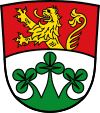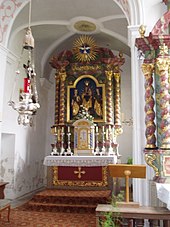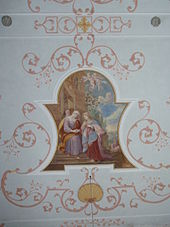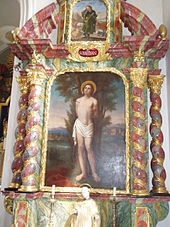Hitzhofen
| coat of arms | Germany map | |
|---|---|---|

|
Coordinates: 48 ° 51 ' N , 11 ° 19' E |
|
| Basic data | ||
| State : | Bavaria | |
| Administrative region : | Upper Bavaria | |
| County : | Eichstatt | |
| Height : | 445 m above sea level NHN | |
| Area : | 33.79 km 2 | |
| Residents: | 2947 (Dec. 31, 2019) | |
| Population density : | 87 inhabitants per km 2 | |
| Postal code : | 85122 | |
| Area code : | 08458 | |
| License plate : | EGG | |
| Community key : | 09 1 76 132 | |
| LOCODE : | EN HI9 | |
| Community structure: | 5 parts of the community | |
| Address of the municipal administration: |
Kirchweg 12 85122 Hitzhofen |
|
| Website : | ||
| Mayor : | Roland Sammüller ( SPD ) | |
| Location of the municipality of Hitzhofen in the Eichstätt district | ||
Hitzhofen ( Bavarian Hitzhofa ) is a municipality in the Upper Bavarian district of Eichstätt . The place of the same name is both the capital and the seat of the municipal administration.
geography
The place Hitzhofen is in the Ingolstadt region, about twelve kilometers southeast of Eichstätt and three kilometers north of Eitensheim on the plateau of the Southern Franconian Alb .
Community structure
The municipality has five officially named municipal parts (the type of settlement is given in brackets ):
- Baumfeld ( wasteland )
- Hitzhofen ( parish village )
- Hofstetten (parish village)
- Mühlthal (wasteland)
- Oberzell ( village )
The community part is about three kilometers north of Hitzhofen. Oberzell joins Hitzhofen to the northwest. Mühlthal is one kilometer to the west, Baumfeld one and a half kilometers north of Hitzhofen.
history
Until the church is planted
Hitzhofen is on a pre-Roman road. In 1129 a "Udalrich de Hutishoven", a local nobleman, was named as Eichstätter Ministeriale. In the 12th century, the Plankstetten monastery owned here. Later the place came to the Hochstift Eichstätt , which from 1500 was in the Franconian Empire .
The office of the Hochstift Eichstätt fell in the Reichsdeputationshauptschluss 1803 with most of the Hochstift area to the Principality of Eichstätt of Archduke Ferdinand of Tuscany . Since the peace treaties of Brno and Pressburg in 1805, the place has belonged to Bavaria. In the course of the administrative reforms in the Kingdom of Bavaria , today's municipality was created with the municipal edict of 1818 .
In the 1861 census, the place Hitzhofen had 272 inhabitants and 61 buildings, Hofstetten 348 inhabitants and 143 buildings, Oberzell 151 inhabitants and 56 buildings.
Administrative history
Since the regional reform , which came into force on July 1, 1972, it has belonged to the Upper Bavarian district of Eichstätt in its new form. From May 1, 1978 to December 31, 1993 she was a member of the Eitensheim administrative community , and since 1994 it has again been a unified community with its own administration.
Incorporations
On January 1, 1971, the previously independent municipality of Oberzell was incorporated. Hofstetten was added on May 1, 1978.
Population development
Between 1988 and 2018 the municipality grew from 1,928 to 2,926 by 998 inhabitants or 51.8%.
- 1961: 1270 inhabitants
- 1970: 1467 inhabitants
- 1987: 1892 inhabitants
- 1991: 2111 inhabitants
- 1995: 2358 inhabitants
- 2000: 2496 inhabitants
- 2005: 2745 inhabitants
- 2010: 2871 inhabitants
- 2015: 2871 inhabitants
religion
There are the Catholic parishes of Hitzhofen / Lippertshofen for brother Klaus von Flüe and Hofstetten St. Nikolaus. Parish seat is Hitzhofen; there is also the parish home of St. Willibald.
politics
Municipal council
After the local elections on March 15, 2020, the municipal council of Hitzhofen has 14 members from the following parliamentary groups:
- CSU : 6 seats
- SPD : 6 seats
- Citizens' forum : 2 seats
mayor
Mayor has been Roland Sammüller (SPD) since May 1, 2014.
coat of arms
| Blazon : “Divided by red and silver; above a golden lion growing out of the dividing line, below a green shield foot drawn out into three three-leaf clover leaves. " | |
Culture and sights
Hitzhofen
- The old parish church "Mariä Visitation" is a baroque building from 1722. A previous church was consecrated between 1182 and 1189 by Bishop Otto von Eichstätt . In 1594 it was restored and consecrated and over time it became a much-visited pilgrimage site; In addition, there was the old Marian pilgrimage “Maria im Klee”, the origin of which is still obscure, in the 18th century. The saying is still known today: “ Appertshofen am See, Hitzhofen im Klee, Pettenhofen am Sand, three churches are well known.” Around 1596 the tower received its current appearance with the battlements. Gabriel de Gabrieli either rebuilt the nave in 1722/23 or redesigned and extended it and rebuilt the sacristy ; it is his first church building in the Eichstätt district. The construction manager was Johann Rigalia the Younger . Later, in 1728, the choir arch was broken out and raised. The stucco work , probably by the Eichstätt plasterer Jakob Egg , and the ceiling paintings are from 1722. The consecration took place on October 4th, 1722. The high altar is baroque from 1700. Instead of an altarpiece, there is a pilgrimage picture in a niche, a wooden statue of Mary (from 1470 / 80). The side altars are also baroque, dating from around 1700; the altarpieces are later painted in the Nazarene style . The stucco pulpit is an early Rococo work from 1722 by Giuseppe Venino. - The legend tells that there was a women's monastery in Hitzhofen in the Middle Ages, perhaps it was related to the local nobility of Hitzhofen, of whom a Heinrich von Hütteshofen is mentioned in 1289.
- The new parish church "Nikolaus von der Flüe" was built in 1966/67 by the Munich architect F. Haindl as a central building in the form of an irregular pentagon, the center of which is the altar, and contains older works of art. It is connected to the old church by a low building containing the sacristy .
Hofstetten
- Jurassic Farm Museum
- The former prince-bishop's hunting lodge, now privately owned, was incorporated into the Eichstätt Monastery in 1466. In 1694 the castle, a rectangular pond complex with a medieval keep, was completed in its present form by Jakob Engel . It was heavily plundered by the Swedes during the Thirty Years War. In addition to the prince-bishop's hunting purpose, the castle served the Ingolstadt Jesuits as a holiday home.
- The parish church of St. Nikolaus is a baroque new building from 1710, which was built by order of Prince-Bishop Johann Anton I. Knebel von Katzenelnbogen according to plans by Jakob Engel , and was replaced in 1896 by a neo-Gothic new building by Friedrich Niedermeier , Regensburg. With the restoration in 1937/38, the baroque furnishings of the previous building were restored. Bishop Otto von Eichstätt consecrated a previous church here between 1182 and 1189, of which the tower still stands; A baroque structure from the 18th century with a dome rises above the Romanesque substructure. Of the wooden figures inside, a late Gothic relief of the birth of Christ with three singing angels is worth mentioning (around 1480). Saint Joseph with the baby Jesus is a "noble work" (Mader, art monuments) around 1780, possibly by Joseph Anton Breitenauer . On the right wall of the nave hangs a Renaissance crucifix from Loy Hering's workshop . The baroque pulpit was acquired in 1960 from St. Sebasti, Ingolstadt. In the cemetery you can find some tombstones from the Rococo period and Classicism .
- The former rectory is first mentioned in 1616. It has the coat of arms of the Eichstatt Prince-Bishop Johann Christoph von Westerstetten and is a two-storey building in the Jura house style.
- West of Hofstetten, the remains of a late Celtic square hill have been found.
- List of architectural monuments in Hofstetten .
Wattenhofen
- St. Vitus chapel of the abandoned town of Wattenhofen, with a former cemetery, consecrated by Bishop Gundekar II (r. 1037-1075), 1742 construction of a hermitage by Jakob Horneis, demolished in 1803 by order of the Tuscan government including the hermitage, the chapel in 1850 newly built. Inside there is a wooden sculpture of St. Vitus .
Oberzell
- In the vicinity of Oberzell there are barrows from the more recent Hallstatt period .
Mühlthal
- A chapel from 1852 is located in the Mühlthal part of the municipality, which has been a prince-bishop's prince-bishop since the disputes over the Hirschberg legacy in 1305.
- To the north of the hamlet there is a burial mound from the Hallstatt period.
Architectural monuments
Economy and Infrastructure
Economy including agriculture and forestry
The municipal tax revenue in 1999 was the equivalent of 5150 thousand euros, of which (net) the equivalent of 721 thousand euros was trade tax income. In 1998, according to official statistics, there were no employees in the manufacturing sector and no employees in the trade and transport sector at the place of work. In other economic sectors 541 people were employed at the place of work subject to social security contributions. There were a total of 2,767 employees at the place of residence subject to social security contributions. There was one company in the manufacturing sector and five companies in the main construction sector. In addition, in 1999 there were ten agricultural holdings with an agriculturally used area of 191 hectares, of which 181 hectares were arable land and ten hectares were permanent green space.
education
In 2006 there were the following institutions:
- Kindergartens: 125 kindergarten places with 125 children
- Crèche with 16 places.
- Elementary schools: one with 11 teachers and 238 students
Personalities
- Siegfried Schneider (* 1956), Member of the Bundestag, Bavarian State Minister as Head of the Bavarian State Chancellery, and Chairman of the CSU Upper Bavaria; since October 1, 2011 President of the Bavarian State Center for New Media.
literature
- Johann Kaspar Bundschuh : Hitzhofen . In: Geographical Statistical-Topographical Lexicon of Franconia . tape 2 : El-H . Verlag der Stettinische Buchhandlung, Ulm 1800, DNB 790364298 , OCLC 833753081 , Sp. 685 ( digitized version ).
- Johann Kaspar Bundschuh : Hofstetten . In: Geographical Statistical-Topographical Lexicon of Franconia . tape 2 : El-H . Verlag der Stettinische Buchhandlung, Ulm 1800, DNB 790364298 , OCLC 833753081 , Sp. 723 ( digitized version ).
- Pleikard Joseph Stumpf : Hitzhofen . In: Bavaria: a geographical-statistical-historical handbook of the kingdom; for the Bavarian people . Second part. Munich 1853, p. 706 ( digitized version ).
- Pleikard Joseph Stumpf : Hofstetten . In: Bavaria: a geographical-statistical-historical handbook of the kingdom; for the Bavarian people . Second part. Munich 1853, p. 737 ( digitized version ).
- Felix Mader (editor): The art monuments of Bavaria. Middle Franconia. II. Eichstätt District Office. Munich 1928. (Reprint 1982.) P. 128 f.
- Theodor Neuhofer: The parish church Hitzhofen. In: Historical sheets for the city and district of Eichstätt. 2. Vol., No. 15 (recte: No. 5), 1953, pp. 17-19.
- Collective sheet of the historical association Eichstätt. 60, 1962/1964, pp. 45-49.
- August Sieghardt and Wilhelm Malter: Altmühltal. 3. Edition. Glock and Lutz, Heroldsberg 1979, pp. 203-205.
- Karl Zecherle and Toni Murböck: Churches and monasteries in the Eichstätt district. Hercynia, Kipfenberg 1983, pp. 40 f., 118 f.
- Karl Zecherle (editor): Castles and palaces (in the Eichstätt district). Hercynia, Kipfenberg o. J. (1983), p. 24 f.
- The Eichstätter area past and present. 2nd Edition. Eichstatt 1984.
- Ludwig Böhm: Chronicle Hitzhofen. Apa, Hofstetten 1989.
- St. Veit near Hofstetten. In: Heimgarten, 17th year, 1936, No. 29, p. 114
Web links
Individual evidence
- ↑ "Data 2" sheet, Statistical Report A1200C 202041 Population of the municipalities, districts and administrative districts 1st quarter 2020 (population based on the 2011 census) ( help ).
- ^ Hitzhofen community in the local database of the Bayerische Landesbibliothek Online . Bavarian State Library, accessed on September 14, 2019.
- ^ Joseph Heyberger, Chr. Schmitt, v. Wachter: Topographical-statistical manual of the Kingdom of Bavaria with an alphabetical local dictionary . In: K. Bayer. Statistical Bureau (Ed.): Bavaria. Regional and folklore of the Kingdom of Bavaria . tape 5 . Literary and artistic establishment of the JG Cotta'schen Buchhandlung, Munich 1867, Sp. 1012-1013 , urn : nbn: de: bvb: 12-bsb10374496-4 ( digitized version ).
- ^ Wilhelm Volkert (ed.): Handbook of Bavarian offices, communities and courts 1799–1980 . CH Beck, Munich 1983, ISBN 3-406-09669-7 , p. 456 .
- ^ Federal Statistical Office (ed.): Historical municipality directory for the Federal Republic of Germany. Name, border and key number changes in municipalities, counties and administrative districts from May 27, 1970 to December 31, 1982 . W. Kohlhammer, Stuttgart / Mainz 1983, ISBN 3-17-003263-1 , p. 599 .
- ↑ wahl.info: Local council election & mayoral election in Hitzhofen 2020 - candidates & results. Retrieved August 26, 2020 .
- ^ Municipality of Hitzhofen: local council. Retrieved August 26, 2020 .
- ↑ Mayor. Congregation, accessed August 18, 2020 .
- ^ Entry on the coat of arms of Hitzhofen in the database of the House of Bavarian History
- ↑ Heimgarten, Volume 17, 1936, No. 29, p. 114










